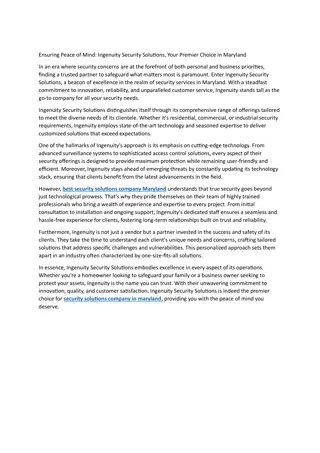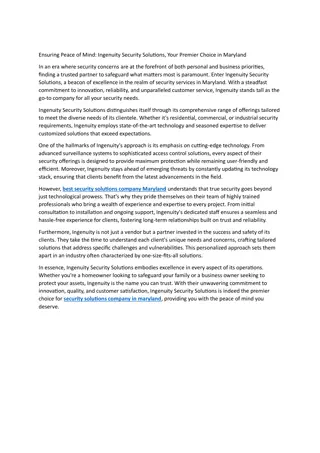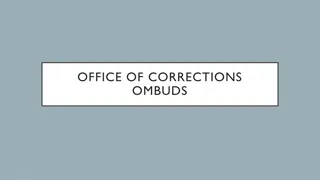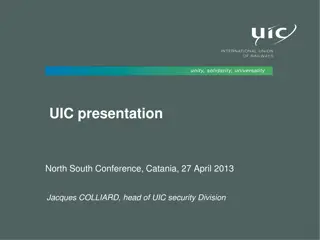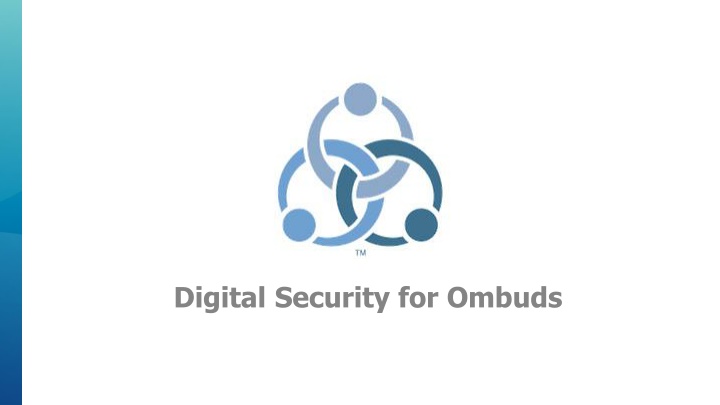
Ensuring Digital Security for Ombuds: Risks and Best Practices
Discover the challenges of integrating digital tools into ombuds services, including risks like unauthorized data access and system compromise. Learn about the different types of risks involved and explore security concerns related to tools such as email, video conferencing, and text-based communication. Find out essential security practices to safeguard ombuds operations in the digital realm.
Download Presentation

Please find below an Image/Link to download the presentation.
The content on the website is provided AS IS for your information and personal use only. It may not be sold, licensed, or shared on other websites without obtaining consent from the author. If you encounter any issues during the download, it is possible that the publisher has removed the file from their server.
You are allowed to download the files provided on this website for personal or commercial use, subject to the condition that they are used lawfully. All files are the property of their respective owners.
The content on the website is provided AS IS for your information and personal use only. It may not be sold, licensed, or shared on other websites without obtaining consent from the author.
E N D
Presentation Transcript
Digital Security for Ombuds Challenge: The introduction of digital tools into ombuds creates risks around unauthorized data access and system compromise. Different Types of Risks: Internet security: risk by the interconnection to the public network; System security: risk of malfunction or improper operation of digital system; Algorithm security: risk of algorithm ethical principles; Operator security: risk of operator qualifications or dishonesty; Trust security: risk of credible data communication to other digital systems.
What types of tools are ombuds using? Email Calendar invitations Word documents Skype calls Google docs Text messages Social media platforms These tools all have security concerns These tools all have security concerns
Email security Emails travel across multiple networks and servers before arriving in their intended audience s inbox. Emails aren't encrypted Servers hold emails that are decades old, even after they're deleted Once your password is compromised, all emails are accessible Emails touch multiple devices (e.g. laptop, mobile, watch) each of which can be compromised The sender cannot prevent recipients from further forwards
Secure text-based communication Email/SMS notifications should never contain substantive communications All substantive communications should be on a password-protected ODR platform Require two factor authentication, or complex passwords, for platform access Don t email attachments share documents in a password-protected file repository
Videoconferencing security risks Who has access? Zoom bombing Are all participants visible? Other people in the room, off camera What is being recorded? Can the session be secretly recorded? Phone on record next to the speaker Can someone intercept the video feed? Who can control your local machine? Is location tracked by the application?
Videoconferencing Security Steps Use a secure videoconferencing platform with end- to-end encryption Do not use apps or software that require location information to be shared, or inform the parties that they have the ability to turn that off (and explain how to do so) Use waiting rooms, passcodes, and room locking to prevent unauthorized access Don t record your sessions
ODR SECURITY GUIDELINES ICODR is working on ODR Security Guidelines https://icodr.org
Security Best Practices Require training for ombudspeople in data security Don t use open platforms for ombuds use systems that are purpose-built for ombuds Only use ombuds platforms that have been security certified (ISO 27001/SOC 2) Require routine security audits and penetration tests for ombuds platforms
Security Questions What obligations do ombuds have around security? What obligations do ombuds platform providers have around security? What are the top five things ombuds can do to make their online work more secure? Can a ombudsperson be held liable for poor information security practices? Can an outcome be challenged on the basis of IT security concerns? What disclosure obligations do ombuds platform providers have in the event of a data breach? Should there be sanctions for ombudspeople and ombuds platforms that don t abide by industry standards around data security? How can an individual know whether their ombudsperson is being responsible with their information? 1. 2. 3. 4. 5. 6. 7. 8.










